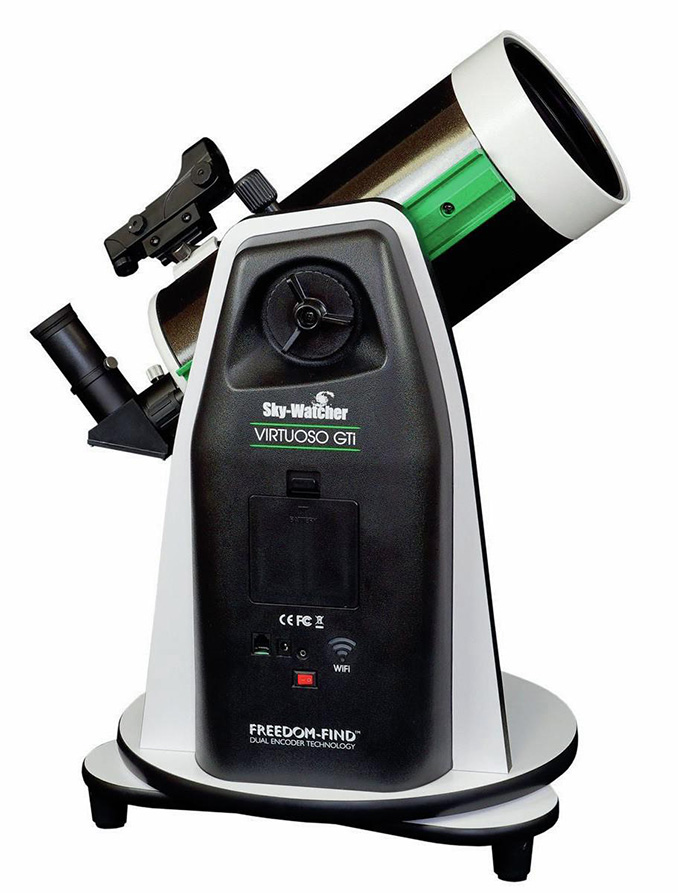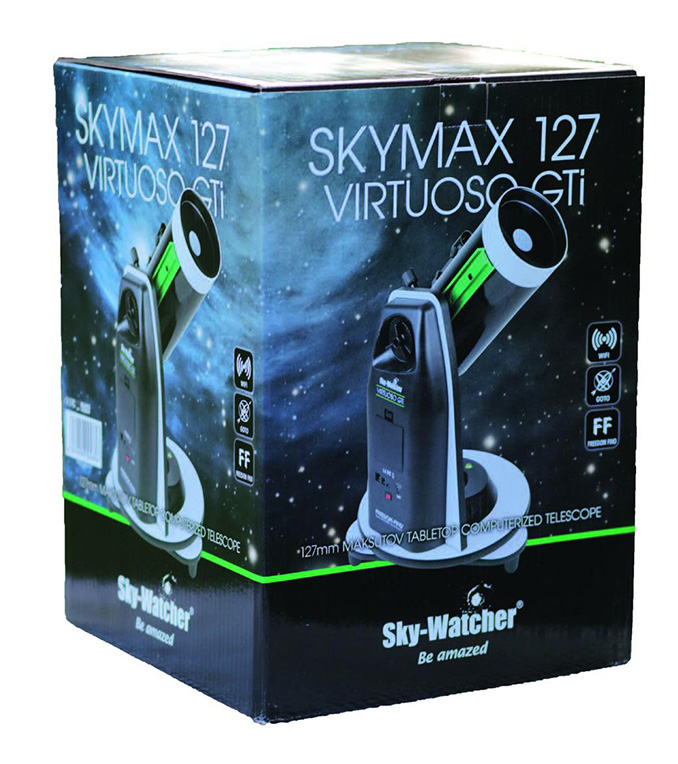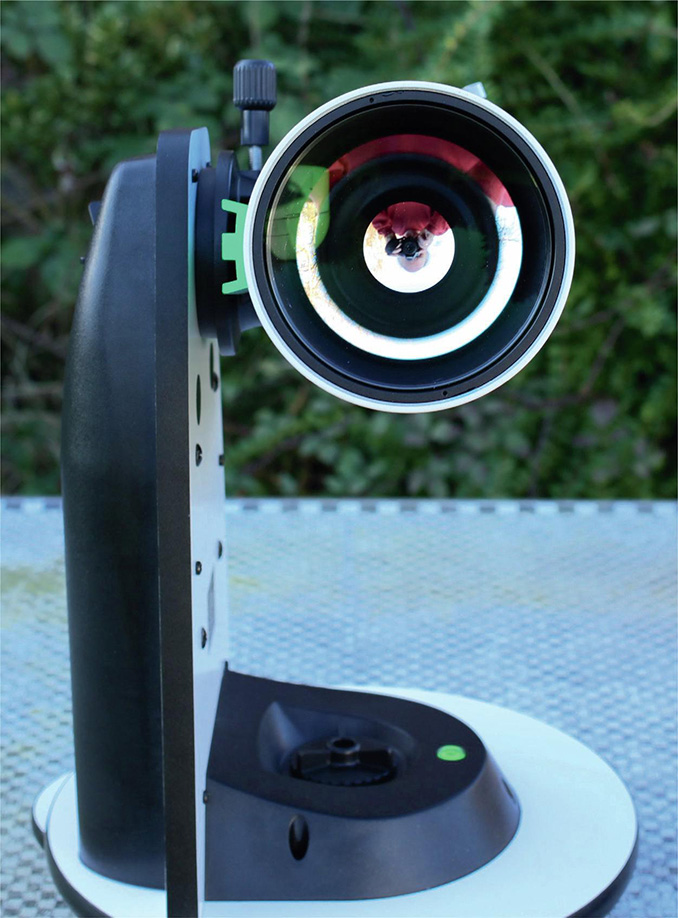
Inexorable urbanisation of our environment is steadily robbing potential observers of their birth-righted opportunity to view the wonders of the night sky. But we can now fight back. Technology and design innovations are making possible rapid-deployment set-ups with observatory-style capabilities but which do not require an observatory, making them ideal for those who need the ability to observe from cramped gardens or who are willing to travel a distance to find better skies. This telescope–mount combo from Sky-Watcher aims to meet this need – a mating of the Virtuoso GTi alt-az mounting and the SkyMax 127mm Maksutov–Cassegrain telescope. I was eager to find out if this was a marriage made for the heavens.

The whole kit comes already assembled – all you need to begin observing is to load up the power (either eight AA batteries or a one amp DC supply) and fit the supplied star diagonal and one of the two provided eyepieces. Deployed, the whole assembly is no more than 45cm high (tube horizontal), within a zone not greatly exceeding 30cm in diameter – a concise set-up indeed.

A small, circular garden table suits the Virtuoso GTi SkyMax 127 down to the ground. A large table would prevent access from all angles.
The mount
The tabletop mount is essentially a small, motorised Go-To alt-az Dobsonian that will sit on any surface greater than 30cm in diameter. You do, of course, require a table sensibly small enough to allow access from all angles, otherwise there will be a need for ungainly and uncomfortable leaning to get access to the eyepiece. I have a round garden coffee table of about 60cm diameter and that worked well as an impromptu observatory base.
The mount’s baseplate is underpinned by three rubber feet, for non-slip contact. Oddly, bearing in mind that the mount also features a bubble level, these feet are not height adjustable as one might expect. Attaching the rubber feet to adjustable bolts would surely be a disproportionately cheap and simple way of vastly improving the baseplate. If this was my purchase, such an enhancement would be my first retro-engineering task, using bolts and pronged t-nuts into the wooden baseplate. I would probably also attach a larger bubble level, since the 15mm diameter fitted one, although adequate, does not offer the greatest resolution in this regard.
The baseplate usefully offers a 3/8-inch standard photo bush, enabling the assembly to be firmly hoisted on top of a stout tripod (not included). It is in this configuration that I continued with the review since it afforded a means of altering the viewing height – not so possible when deployed on a table.
Regarding power supply, I was really pleased to see that the battery-pack connector used robust wiring, rather than the fragile ‘fairy threads’ too often seen that break away from the circuit board after perhaps a couple of battery changes.

The telescope
The telescope is a Maksutov–Cassegrain of 127mm aperture. Although the focal length is 1,500mm (making the instrument f/11.8) the optical design folds this into a very practical 33cm tube. The back plate offers a combined T-thread and 1.25-inch eyepiece port, with focusing enabled by a ribbed finger knob to the side of the port. Other tube furniture is a mini-dovetail saddle for the supplied red-dot finder, plus the pre-fitted 26cm dovetail bar that runs almost the entire length of the telescope.
Although the kit can be used manually, underpinning the telescope and mount is Sky-Watcher’s long-developed propriety Go-To software, SynScan. The mount offers an RJ-12 port for connecting the (optional) Sky-Watcher handset, but most will download SynScan’s smartphone software and operate the telescope via Wi-Fi connection.
I did find the process of Wi-Fi connection unduly cumbersome. You first need your smartphone to connect to the Wi-Fi network that the mount is transmitting, then on that network find the device that is transmitting it – which seems a bit circular to me. However, I mentally shrugged and got on with it.

Set-up
The first thing I did was to confirm that the telescope’s optics had been delivered as intended. Locating Procyon, first with the supplied low-power 25mm eyepiece (60×), I switched to its 10mm sibling for a higher power (150×) examination of the star’s extra-focal image. Transport had not disturbed a bang-on collimation – and with the advantage of still, night air kindly hovering just above freezing, the assessment also revealed beautiful diffraction rings that bore a promise of excellent optical quality. This initial use also demonstrated that the focuser mechanism was buttery smooth and creditably displayed no image shift.
Once I had Procyon in my sights, I took the opportunity to line up the red-dot finder to the telescope’s axis. This was easy enough, facilitated by two adjustment wheels on the unit. However, I did find the LED’s red dot rather too bright (even when adjusted to its lowest level) and it tended to drown out all but the brightest stars. Even Sirius had a job breaking through. The finder’s glass element did not pass starlight too well and I adjudged the finder would not accommodate stars less than third magnitude. It is perhaps a useful approximate targeting device for the brighter constellations, but no more. The tube shoe, of course, will accept a conventional optical finder.
To be fair to the system as a whole, once the SynScan Go-To software is up and running, there is little need for a finder.
SynScan is a highly developed piece of fully functional Go-To software that is used by Sky-Watcher across many platforms. It offers multilevel initial alignment and pointing facilities, and its database allows access to more than 10,000 celestial objects. The Virtuoso GTi mount also offers a SNAP port through which SynScan can control attached DSLR cameras.
What we have here, then, is a rapid-deployment, comprehensive observing and imaging facility.

On trial
Initial start-up offers a choice of several mount orientation procedures, including single, brightest and three-star alignments. I began with a single-star alignment and found that requested targets, while not central in the eyepiece field, were accessible well within the zone of the red-dot finder.
My first experiment with a two-star alignment was nothing short of miraculous. From SynScan’s offered list of current stars above the horizon, I chose Rigel and Polaris. With their being diametrically opposite in the sky, I judged that this would result in a good alignment. I was right. Subsequently initiating a Go-To slew to Gemini’s Castor, the target star arrived without fluster, dead centre in the field of the 10mm eyepiece. It was a pretty impressive performance from a mount temporarily planted on a lawn. Such unerring execution was not always achieved, but my target was always within the field of the low-power eyepiece (or at worst, close to the middle of the red-dot finder) – which is good going.
SynScan, like any software that has undergone continuous development for many years, does involve a steep learning curve if you have not met it before – especially some of the deeper functionality – but it is worth it. I did come up against what I thought were one or two idiosyncrasies, but once I comprehended what it expected of me, we got along fine.
One thing I would say about using a smartphone (or similar device) via the Wi-Fi connection is that although the software’s facilities can be displayed with infinite variation, the smooth interface of a glassy surface does not allow blind fingers to feel the graphic interface of those virtual target ‘buttons’. Unlike a physical handset with tactile protruding buttons, a virtualised smart-screen (albeit moderated by an automatic red light mode) under these circumstances requires the user to take their attention from the eyepiece to look at the screen (to place a finger appropriately) then return their gaze to the eyepiece – with ongoing to-and-fro as necessary. For those who use glasses for reading but not observing, the situation is compounded, since switching from the SynScan screen to the eyepiece and back again also incurs swapping spectacles on and off, and on, and off again. This can become irksome when (for instance) you are gently slewing to land a target centre field while controlling the mount to impart that motion, as is necessary during the alignment procedure. This is a task for two eyes, but each looking in different directions like a chameleon. I did try holding the screen close to the eyepiece and using both eyes simultaneously, with some success, but observers who do use glasses may wish to avail themselves of the Sky-Watcher handset, available separately.
Tracking
The tracking ability of the mount is very good. I tested this by centring Sirius and abandoning the set-up to its fate for over an hour – only to find on my return that the star had hardly strayed from the middle of the field. Short term, there is a detectable small deviation about a mean, but the SynScan software has periodic error correction, and this can be enabled to remove this remaining degree of wander.

The sky
The telescope’s focal ratio of nearly f/12 suits it perfectly for Solar System objects and double/multiple star observation. By the time of my review period, both Jupiter and Saturn had seized the chance of extended poor weather to dive sunward out of view, leaving only Uranus as a practical planetary target.
Following a two-star alignment, the telescope found Uranus and placed it centre stage. The 10mm eyepiece showed it as a sharply defined, weakly green disc – a very pleasing view. The focusing is very smooth on the SkyMax and I had no problem at all achieving a good, crisp focus of the planet’s four arcsecond disc.
En passant, both the 10mm and 25mm eyepieces feel very light and ‘tinny’, but optically they held their own and I could not fault them on any of the objects I used them on.
One bright sunny day, another member of the Solar System offered itself for view. Quite by chance, I found that one of my full-aperture glass solar filters mounted snugly over the end of the SkyMax’s tube. With no alignment stars available (save the big one nearby) I used the level north alignment procedure, and this worked a treat – slewing obediently to the Sun with only a Sun-proximity warning from SynScan to impede the process.
I was rewarded with a fine display of large sunspots, the Sun finally creeping its way towards maximum activity after the rather extended low of recent years. Detail was magnificent, umbral and penumbral features showing up very cleanly.

Lunar gazing
Mid-January offered a reprieve from the month’s otherwise incessantly overcast sky, providing a brief window onto a gibbous Moon just past full. The 25mm eyepiece yields a real field of about 0.75 degrees, so the half-degree lunar disc was nicely framed with room to spare. Two craggy craters, Langrenus and Vendelinus, hogged the lunar terminator limelight, with mighty Petavius just to the south. Both the 10mm and 25mm eyepieces acquitted themselves well, revealing fine detail.
Seeing conditions were so favourable that I decided to push the SkyMax further into Petavius, deploying a 4.8mm Nagler to elicit a power of 312×. This eyepiece’s wide field enfolded much of the crater’s surroundings, but the SkyMax did excellent work in revealing the terracing of the inner ramparts and the inner mountainous jumble was cleanly picked out – as was the crater’s enigmatic umbilical channel that joins it to the crater rim.
Having got satisfyingly up close and personal, I pulled a long way back from the Moon using a 40mm eyepiece, to a diminutive 37×. The disc swam in the larger field of sky, but drawing back gave the ray system of the almost full Moon a chance to shine. It was very striking with the instrument delivering excellent contrast on such a challenging ‘floodlit’ subject – and as equally satisfying as the magnified view provided by the Nagler.

The deep
As mentioned, f/12 is a fine focal ratio for the Solar System, but I was interested in how the telescope would perform on deep-sky objects, of which the winter sky is rather overburdened.
Messier 42 in Orion is the season’s telescopic magnet and using the 25mm I had a great view of the nebula – including a well-resolved stellar quartet of the Trapezium at its centre. The wider view provided by my 40mm eyepiece took in the brighter ‘wings’ of the inner cloud and the stellar surroundings. It was a beautiful, well contrasted scene.
Looking higher up towards the west in Taurus, the field of my 40mm eyepiece enfolded the brighter members of the Pleiades perfectly. It was a great classic view of this star cluster, enjoyed all the more as it firmly testified to the quality of the optics, stellar-wise, in depicting the Pleiads with equal fidelity across the field.

Freedom
One of the benefits of the Virtuoso GTi mount is a well-promoted feature called Freedom Find. This allows a user to disengage from the Go-To mechanism mid-session for a free-flight change of target without disturbing the alignment and Go-To facility. My only criticism of this useful ability is one of nomenclature. You are required to switch this facility on within SynScan, but try as I might, I could not find the option anywhere in the software; until, that is, I realised that within SynScan it is called ‘enabling the Auxiliary Encoder’. The software engineers and product scripters need to get together on this.
Freedom Find is performed by unclamping the axes and spinning the telescope to wherever the alternative target may be. Afterwards, the Go-To abilities can be re-engaged without loss of position. I learned the hard way that for this to work, the al Fresco move has to be carried out with the clamps fully loosened. For this reason, the tube assembly needs to be well-balanced before a session is initiated, but this is always good practice anyway. I tested the Freedom Find ability a few times and it worked well.
Conclusion
Both mechanically and optically, the SkyMax 127 Virtuoso GTi is a great performer and a very useful rapid-deployment instrument. The aperture and focal length give it access to a huge field of astronomical objects and are able to elicit useful detail. The mount’s control system gives the telescope the ability to seek out all that it needs to with observatory-standard finesse. You can hardly ask for more that is deliverable in box just 41cm × 41cm × 56cm!
At a glance
Optical type: Maksutov–Cassegrain
Aperture: 127mm
Focal length: 1,500mm
Focal ratio: f/11.8
Supplied eyepieces: 25mm (60×), 10mm (150×)
Fittings: Red-dot finder
Optical back: T-mount and 1.25-inch push-fit
Tripod bush: 3/8th screw fitting
Interface: SynScan hand-controller port, DSLR shutter release port (optional cables available separately), built-in Wi-Fi module
Connectivity: ASCOM platform for Windows, mobile planetarium app for iOS and Android
Operation: via handset or SynScan software
Database: 10,000+ objects plus ‘tonight’s best’ tour
Power: Eight AA batteries or external DC 7.5~14V
Total weight: 10kg
Price: £549
Details: opticalvision.co.uk



